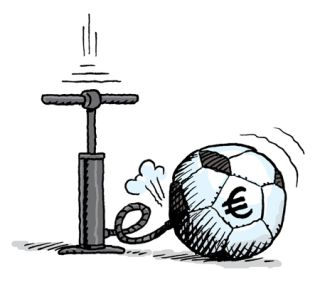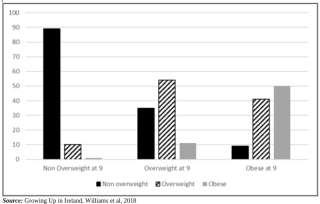Sports and Recreation Facilities in Ireland

1.58 million people in Ireland regularly participate in sports. [1] This represents an drop of about 200,000 since 2019 and based on current population projections, an additional one million people will need to participate in sport on a regular basis in order to achieve the 2027 target set by the National Sports Policy 2018-2027.
Adult Participation in Sports
In general, men are more likely than women to play a sport on a regular basis. The gender gap has been closing, from 15.7 per cent in 2007 to 3.4 per cent in 2019, widening in 2021 to 4.9 per cent (as it was in 2017). The gap between the active sports participation between men and women may be due to the closure of inside spaces within which to exercise and the halting of many team sports for some parts of 2020 and 2021. However at one point during 2020, there was no difference between the genders in their participation levels in sport. In 2021, there was a notable decline in sports participation among less affluent groups and those with lower levels of education. Three-quarters of those with a disability do not participate regularly in sport. Overall, 41 per cent of the adult population meet the national physical activity guidelines through participating in at least 30 minutes of moderate or greater intensity exercise or physical activity at least five times per week.
Child Participation and Outdoor Play
Child participation in sport deceases with age. Eighty per cent of primary school children in the Republic of Ireland participate in a community sport at least once a week, compared to 58 per cent of post primary school children. [2] The gap for school sport is narrower (70 per cent of primary school children play a school sport at least once a week compared to 63 per cent of post primary school children), however with just 17 per cent of primary school children and 10 per cent of post-primary school children meeting the physical activity guidelines, more work is needed outside of the school environment to support child physical activity.
Organised sport does not appeal to every child, and physical activity through outdoor play is especially important to ensure that children are encouraged to get active. Outdoor play is also important for socio-emotional and cognitive development. A recent study on the importance of outdoor play, based on the Growing Up in Ireland data, found that although the majority of Irish children engage in some form of outdoor play, neighbourhood safety was a concern among some parents who limited their children’s outdoor play time due to heavy traffic, adequate/appropriate outdoor play facilities in their area, poor condition of footpaths, roads and lighting, or littering.[3] This study does not look at the socio-economic profile of the children involved; however, it provides a clear indication that investment in neighbourhood safety and outdoor play facilities would increase the likelihood of outdoor play among young children.
Child Obesity
Child obesity is increasing across many developed countries and is a cause for concern for the future health and wellbeing of the population and has been identified by the World Health Organisation European Region as a serious public health problem. [4] The Department of Health, in 2016, launched the Obesity Action Plan 2016 – 2025, ‘A Healthy Weight for Ireland’ as part of the overall Healthy Ireland initiative with a target to decrease by 0.5 per cent a year the level of excess weight in children. 1 in 5 of the primary school children included in a study for 2018 and 2019 were overweight or obese with noticeable differences between children attending schools classified as disadvantaged.[5]
In older children, 20 per cent of 13 year olds are overweight and six per cent are classified as obese, with girls more likely to be overweight or obese than boys.[6] Of those who were non-overweight at 9 years old, 89 per cent have remained so, with 10 per cent becoming overweight and 1 per cent becoming obese in the intervening period. Of those who were overweight at 9 years old, 35 per cent are non-overweight, 54 per cent remained overweight and 11 per cent became obese.
Of those who were classified as obese at 9 years old, 9 per cent became non-overweight, 41 per cent became overweight and 50 per cent remained obese (Chart 1).
Chart 1: Change in Weight Status of 13 year olds since 9 years of age

National Physical Activity Plan
The low rate of participation in physical activity among Ireland’s children and adults, high rates of use of private transport for even short journeys, including the school run which sees approximately only one quarter of primary school children walking, cycling or skating and the increasing prevalence of online shopping means that Ireland is becoming a more sedentary country. The National Physical Action Plan, published in 2016 as part of the Healthy Ireland framework, contains ambitious targets for eight key action areas including children and young people, work places, public awareness and sport and physical activity in the community.
The Report of the Youth Stakeholder Forum on Sport asked how to achieve increased levels of sports participation by young people and found that there is a need to provide more facilities to address current gaps; to share existing facilities more, especially between schools and local communities; to prioritise the development of multi-sport facilities to improve range and variety; develop coaching standards and capability; have a physical activity friendly school uniforms policy; provide better access for young people to sports facilities during peak hours after school; have more active travel to and from sports facilities and improve public transport availability, especially in rural areas; have more time dedicated to a more diverse physical education (PE) curriculum and recognise the need for Gender equality.
Social Justice Ireland commends Government on the initiatives undertaken in furtherance of this plan, such as ‘Park Runs’ and the site ‘getirelandactive.ie’ that recommends physical activities for a range of ages and lifestyles and calls on Government to encourage children and adults, particularly those from a low socio- economic backgrounds to increase their participation in sports through the further development of playgrounds and subsidised sports centres.
Sports and Recreation Funding
The largest and most well-known sports organisation in Ireland is the GAA, whose clubs not only provide a physical outlet for those playing the games, but also as a social and recreational space for people to volunteer. However, maintaining facilities to a high standard, ensuring insurance cover and encouraging wide participation is expensive and there is a need to offer support-funding to clubs in this regard. This is particularly important for sports which do not have access to large gate receipts. Government should be cognisant of the health, societal and economic benefits of sports and social outlets, and provide sufficient ring-fenced funding to complement this voluntary effort.
A source of revenue that could be ring-fenced for sports participation and recreational activities is the Sugar-Sweetened Drinks Tax which was introduced in May 2018 and could provide investment of between €30 and €40 million.[7] If appropriately allocated, this revenue could move Ireland further towards attaining the targets of the National Plan for Physical Activity.
[1] Sport Ireland. 2022. Irish Sports Monitor Annual Report 2021. Dublin: Sport Ireland.
[2] Woods, C. B., Powell, C., Saunders, J. A., O'Brien, W., Murphy, M. H., Duff, C., Belton, S. 2018. The Children’s Sport Participation and Physical Activity Study 2018 (CSPPA 2018). Department of Physical Education and Sport Sciences, University of Limerick, Limerick, Ireland, Sport Ireland, and Healthy Ireland, Dublin, Ireland and Sport Northern Ireland, Belfast, Northern Ireland.
[3] Egan, S., & Pope, J. 2018. On your bike, Outdoor play in Irish 5 year olds. Children's Research Digest , 5(2), 92-98.
[4] Europe WHO-ROf. The challenge of obesity in the WHO European Region and the strategies for response.; 2007
[5] Mitchell L, B.-S. S. (2020). The Childhood Obesity Surveillance Initiative (COSI) in the Republic of Ireland - Findings. Dublin: HSE.
[6] Williams, J., Thornton, M., Morgan, M., Quail, A., Smyth, E., Murphy, D., & O'Mahony, D. (2018). Growing Up in Ireland. National Longitudinal Study of Children. The Lives of 13-year-olds. Dublin: Stationery Office.
[7] For full details on a joint proposal from the Irish Heart Foundation and Social Justice Ireland see http://www.socialjustice.ie/content/publications/reducing-obesity-and-f…